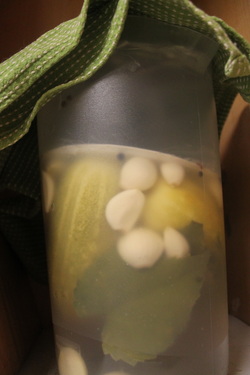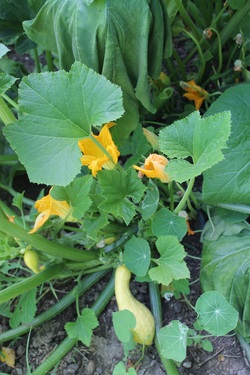
This week at the farm, we have begun what is sure to be a lot of pickling and canning. So far, we have canned peaches and apple butter. The peaches were from a neighbor's house, the apples were grown in our own orchard! In the weeks to come, we will probably be canning tomato sauce as well as different jams. We will also be making a lot of pesto, as we are on the verge of a basil apocalypse.
Canning is fairly straightforward. First, you sterilize your canning supplies (we use ball jars) for about ten minutes. You can do this by putting them in a pot of boiling water. Next, you fill them with whatever you will be canning. Next, you put on the lids and you put them back in the boiling water for a specific period of time, depending on what you are canning (we put our apple butter in for 15 minutes). When the lids pop, you know that the jars have been sealed, and you have successfully canned some food! It is advisable to look up the specifics for what you're canning. The Ball Jar company has a handy manual for this purpose. It is important to note that you shouldn't can stuff with garlic in it-this can lead to botulism, which is some major bad news bears.
Pickling was brought about due to an abundance of cucumbers and the arrival of Sandor Ellix Katz's book Wild Fermentation: the Flavor, Nutrition, and Craft of Live-Culture Foods, which Natalie highly recommends. On Friday night, the pickling adventure began. We were not only able to use our own cucumbers, but also our own dill (for seasoning) and our own grape leaves (for that extra crunch). Hopefully in the future, we will also be able to pickle beets and carrots and we will be able to try out other recipes from Wild Fermentation. Keep an eye out for the farmer's adventures with pickling and canning!
Happy food preservation-
MF
Canning is fairly straightforward. First, you sterilize your canning supplies (we use ball jars) for about ten minutes. You can do this by putting them in a pot of boiling water. Next, you fill them with whatever you will be canning. Next, you put on the lids and you put them back in the boiling water for a specific period of time, depending on what you are canning (we put our apple butter in for 15 minutes). When the lids pop, you know that the jars have been sealed, and you have successfully canned some food! It is advisable to look up the specifics for what you're canning. The Ball Jar company has a handy manual for this purpose. It is important to note that you shouldn't can stuff with garlic in it-this can lead to botulism, which is some major bad news bears.
Pickling was brought about due to an abundance of cucumbers and the arrival of Sandor Ellix Katz's book Wild Fermentation: the Flavor, Nutrition, and Craft of Live-Culture Foods, which Natalie highly recommends. On Friday night, the pickling adventure began. We were not only able to use our own cucumbers, but also our own dill (for seasoning) and our own grape leaves (for that extra crunch). Hopefully in the future, we will also be able to pickle beets and carrots and we will be able to try out other recipes from Wild Fermentation. Keep an eye out for the farmer's adventures with pickling and canning!
Happy food preservation-
MF

 RSS Feed
RSS Feed